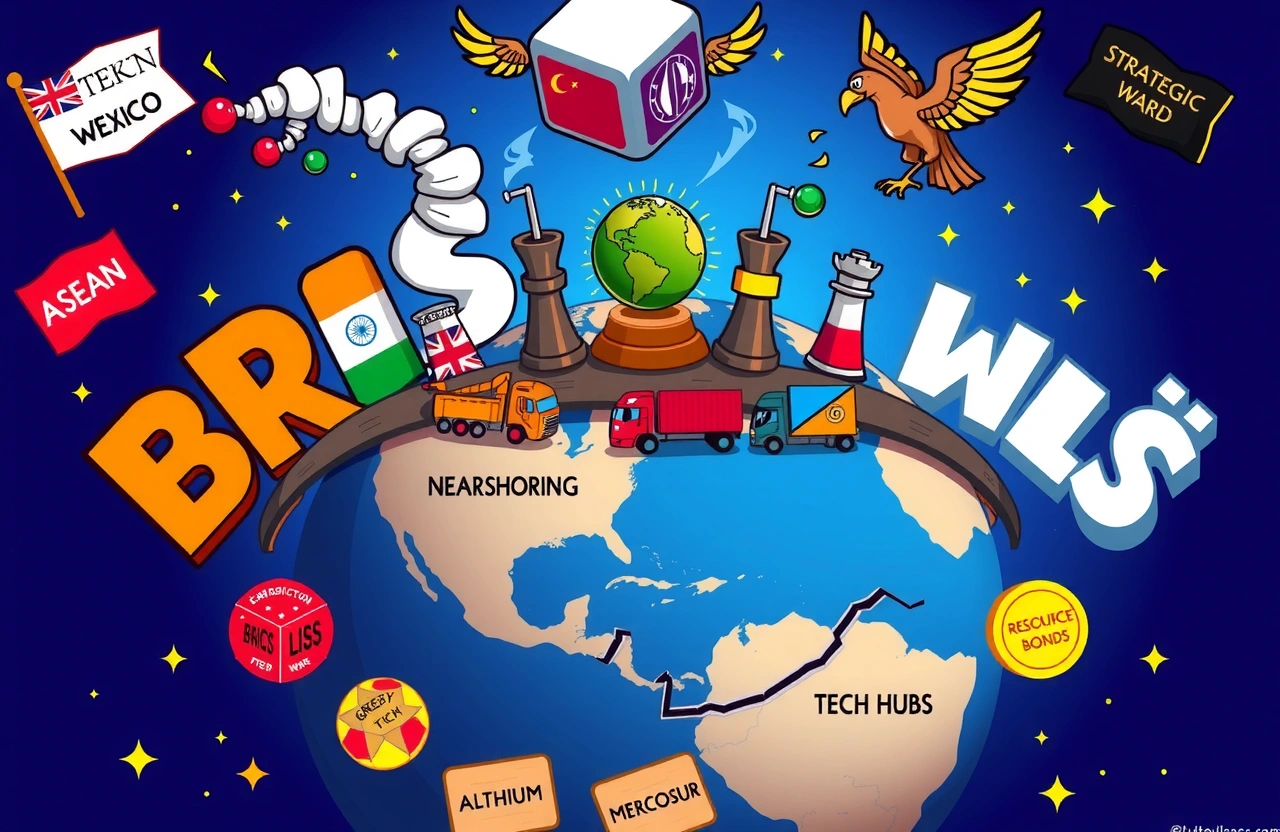The Changing Global Chessboard
Rising great-power competition and regional conflicts have fundamentally reconfigured international relations, creating ripple effects across investment landscapes globally. The Ukrainian crisis, US-China decoupling, and Middle East tensions compose a volatile backdrop where emerging markets must navigate unprecedented challenges and opportunities. These seismic shifts demand fresh approaches to capital allocation, supply chain design, and political risk assessment in developing economies. With traditional Western alliances evolving and South-South cooperation gaining momentum, investors must recalibrate strategies for nations commanding nearly 60% of global GDP. The emergence of new economic blocs – particularly evident in expanded BRICS influence – signals a multipolar world where flexibility becomes paramount for leveraging growth in developing regions.
Supply Chains Redrawn
Global supply networks are undergoing their most significant transformation in decades, with profound implications for production hubs worldwide.
Nearshoring Acceleration
Apple’s billion-dollar investments in Indian iPhone assembly plants and automakers establishing Mexican production bases exemplify how geopolitics drives corporate relocation. Key developments:
- Vietnam gaining $18 billion in foreign manufacturing investment over past two years
- Mexico surpassing China as top US trading partner in 2023
- European manufacturers shifting Eastern European operations to Türkiye and North Africa
The Regional Comprehensive Economic Partnership establishes Asia’s new trade architecture, facilitating supply chain migration throughout Southeast Asia.
Resource Access Reshuffled
Critical minerals necessary for green transitions have become geopolitical bargaining chips. Over 50 nations now impose strategic material export controls, driving exploration investments across Latin America and Africa.
Recent examples:
- Chinese critical mineral investments tripling in Zambia and DR Congo
- Chilean lithium renegotiations altering electric vehicle battery economics
- Indonesia’s nickel export ban shifting cathode production onshore
Investment Dynamics Transformed
Financial flows into emerging markets reflect strategic repositioning rather than opportunistic yield chasing alone.
Beyond BRICS Framework
The lure of emerging markets increasingly requires analyzing political alignment alongside traditional fundamental indicators:
- Sovereign funds prioritizing “friendshoring” compatible nations
- China’s $1.34 trillion Belt and Road evolving focus toward alliance partners
- Sanctions risk assessments becoming mandatory in due diligence
Southeast Asia attracts record capital largely through neutrality positioning, securing $222 billion FDI in 2023.
Sector Spotlight: Technology & Infrastructure
Semiconductor investments highlight new priority sectors:
- Taiwan semiconductor firms establishing European and Japanese facilities
- India awarding $10 billion in chip manufacturing subsidies
- UAE positioning as Middle East tech hub with $3.5 billion data center investments
Infrastructure finance increasingly flows through development banks like New Development Bank rather than Western institutions.
Risk Management Evolution
Traditional financial metrics now coexist with geopolitical analysis in evaluating emerging markets exposure.
Country Risk Analysis Frameworks
Leading consultancies have developed specialized indices incorporating:
- Alliance stability metrics (e.g., bilateral treaties, UN voting alignment)
- Sanctions contagion vulnerability scoring
- Resource nationalism probability modeling
Recent corporate losses demonstrate costly oversight – over $46 billion written off in Russia following Ukraine invasion according to EY analysis.
Strategic Localization Tactics
Success requires nuanced regional implementation:
- Tesla’s Mexican factory using 80% domestic content bypasses tariffs
- ASEAN-Pacific trade agreements utilized for export diversification
- Joint ventures reducing political risk in regulated sectors
Sector Opportunities & Challenges
Diverging sector trajectories reveal geopolitical winners and losers.
Energy Transition Leaders
Resource-rich developing nations experience conflicting pressures:
- Argentina’s Vaca Muerta shale boom amid currency controls
- Saudi Vision 2030 transition milestones versus production quota dilemmas
- African gas projects navigating climate finance pressures
Green hydrogen developments position Morocco, Egypt and Oman effectively within EU energy realignment plans.
Agribusiness Realignments
Agricultural markets reflect fractured trade patterns:
- Brazil-China corn trade replacing Ukrainian supplies
- Indian rice export restrictions destabilizing regional markets
- Gulf sovereign wealth targeting African farmland acquisitions
Strategy Adaptation Toolkit
Adjusting approaches requires updated frameworks tailored to the geopolitical moment.
Portfolio Construction Approaches
Leading institutional investors implement:
- Alliance cluster diversification across geopolitical blocs
- Tail risk hedging through EM bond pricing dislocations
- Sovereign debt restructuring scenario planning
South Africa and México attract attention as neutral destinations balancing multi-polar interests.
Supply Chain Resilience Tactics
Multinationals now incorporate:
- Production footprint stress-testing against conflict scenarios
- Dual supply chain architectures for strategic products
- Chip fabrication requiring multiple geographic solutions
The ongoing emphasis on localization sees Vietnam develop 4 new industrial zones specifically targeting relocated electronics manufacturers.
Pathways Forward
Investors navigating emerging markets require geopolitical acumen matching financial expertise. With alliances trending toward flexible coalitions rather than fixed blocs, continuous monitoring of diplomatic developments becomes essential. Firms adopting scenario-based frameworks outperform peers during unexpected crises. Successful strategies leverage partnerships with local entities possessing nuanced understanding of power dynamics, utilizing public-private initiatives like Indonesia’s geothermal development collaboration with UAE investors.
Regulatory environments will remain dynamic; Mexico’s 2023 mining reforms underscore how policy shifts follow geopolitical positioning. International arbitration clauses gain renewed importance in contracts throughout volatile jurisdictions, as recent Zimbabwe platinum disputes demonstrate. Balancing distributed operations across multiple emerging markets blunts exposure to regional instability, while maintaining agility to capture shifting opportunities.
The next decade demands continuous reassessment of entry approaches and sectoral exposures considering evolving security arrangements. Teams incorporating geopolitical analysts alongside financial professionals position themselves to mitigate risks while identifying undervalued assets in transitioning markets. Industry consortiums establishing common security protocols illustrate practical adaptation. Building scenario prediction capabilities proactively addresses expected volatility before it materializes, preserving value amid uncertainties defining the emerging markets landscape.



